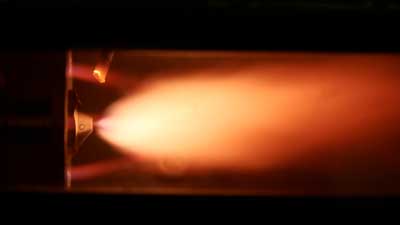| Posted: Sep 17, 2018 | |
New Combustion Synthesis Research Facility heats up high-throughput manufacturing of nanomaterials(Nanowerk News) The U.S. Department of Energy’s (DOE) Argonne National Laboratory announces the availability of a new manufacturing technology that simplifies the manufacture of nanomaterials in high volumes. |
|
| Known as Flame Spray Pyrolysis (FSP), the technology offers significant benefits over traditional methods used to manufacture the particle-based substances that are critical to producing a wide range of industrial materials. | |
 |
|
| Argonne’s new manufacturing technology, shown here, can simplify the manufacture of nanomaterials in high volumes. Benefits include faster production rates and reduced material waste than standard wet chemistry processes. (Image: Argonne National Laboratory) | |
| According to Argonne Principal Investigator Joe Libera, "Flame spray synthesis is a versatile process that allows for commodity-scale production of a very broad range of nanomaterials that includes silica, metallic, oxide and alloy powders or particulate films." | |
| Compared to the wet chemistry processes typically used for synthesizing these materials today, Argonne’s FSP process can deliver cost savings due to faster production rates and reduced material waste. | |
| Argonne’s Combustion Synthesis Facility incorporates a suite of advanced diagnostics that supports the optimization of complex material targets such as aluminum-doped lithium lanthanum zirconium oxide. These enhanced material characterization capabilities enable greater manufacturing precision. | |
| Libera says that, "Although FSP technology is already employed by industry as the cheapest and best way to make carbon black, fumed silica and pigmentary titanium powders, it is not yet widely used for producing more complex materials due to the difficulty in perfecting their characteristics." | |
| This shows the inner workings of the Combustion Synthesis Research Facility at the U S. Department of Energy’s Argonne National Laboratory. | |
| The Combustion Synthesis Research Facility is located at Argonne’s Materials Engineering Research Facility (MERF) outside Chicago, Illinois. Researchers at the MERF can apply Argonne’s highly instrumented FSP process to produce samples at pre-pilot-scale one-day rates up to 500 grams of a single chemistry or up to 50 grams each of up to four different chemistries or process conditions. The facility has a novel clean-in-place fixture that permits daily cleaning of the combustion tube, which permits switching chemistries daily without cross-contamination. | |
| Going forward, Libera will continue to expand the Argonne Combustion Synthesis Research Facility, adding a Planer Laser Induced Fluorescence (PLIF) laser diagnostic system, that uses a tunable laser light sheet to develop a better understanding of the flame chemistries involved. | |
| Building on Argonne’s strengths in discovery science, researchers will build multi-physics simulations of the FSP process that the PLIF diagnostic tool can then validate. Libera also plans to add the capability to test the deposition of flame-made materials directly onto application substrates. | |
| Argonne’s in-situ diagnostics, characterization, computer modeling, scale-up technology and expertise in combustion engineering, aerosol and materials sciences support a wide range of research needs. Taken together, these capabilities enable the MERF to pursue process research and engineering advances that might not be possible in other environments, which is the driving force behind the laboratory’s Manufacturing Science and Engineering initiative. |
| Source: Argonne National Laboratory | |
|
Subscribe to a free copy of one of our daily Nanowerk Newsletter Email Digests with a compilation of all of the day's news. |
